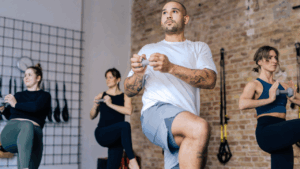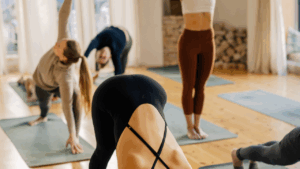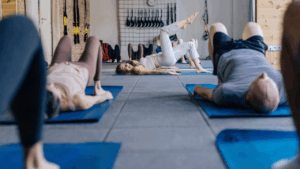
Integration of meditation, breathing techniques and mindfulness in sport
Have you ever seen that you say goodbye mentally during training or your yoga practice-the body carries out the movements while the head is already going through the to-do list for tomorrow? You are not alone with that! The separation between spirit and movement is a silent epidemic that significantly reduces training success.
What if the workout could be a mental detox unit at the same time? This is exactly what happens when mindfulness techniques are connected to physical training - such as in functional training , Pilates , boxing or yoga .
The integration of meditation and breathing techniques such as Pranayama on the move is not an esoteric gimmick. It makes the difference between training that exhausted, and one that changes from the inside.
Mindfulness in sport and sporting performance
Science behind mindfulness and sporting performance
Studies show that mindfulness activates the prefrontal cortex and calms the amygdala - the anxiety center of the brain. This change influences how pressure situations are dealt with.
Brain activity changes measurably during a conscious sports unit. The so-called "alpha state" is created-a state between waking and relaxation in which the performance reaches its peak.
Those who regularly mindfulness recover faster, have lower stress hormone levels and react faster. These effects are scientifically measurable - not mystical.
How meditation focuses and concentration improved
Regular meditation strengthens the ability to concentrate. Already ten minutes a day it can help to better focus boxing combinations or challenging yoga
If the mind is deliberately attributed to breath or movement, this repetition creates a new neuronal structure. Concentration becomes a habit.
The advantages of current perception in training
Anyone who is present at the moment during training recognizes early warning signals of the body before they lead to problems.
This mindfulness also increases enjoyment: every movement is consciously experienced - instead of just checking off the next workout.
Overcoming mental barriers with mindfulness
Sentences like "I don't get through this exercise" or "I'm too tired for a round" are just thoughts - no facts.
Through mindful observing such thoughts without evaluation you can see them as what they are. This creates a distance between stimulus and reaction.
This intellectual freedom leads to physical progress: for example if a: e boxer: also remained calm under pressure, one: e yoga practices de: r breathes through exertion or someone in the Pilates finds more strength than originally thought.
Breathing techniques as the basis for mindful movement for mindfulness in sport
Diaphragm and their effect on performance
Breathing deeply into the stomach - and not just in the chest - can make a fundamental difference in training success.
Displication breathing activates the body's natural relaxation mechanism and at the same time maximizes oxygen absorption. When breathing becomes flat, the shape often suffers. Due to diaphragmic breathing is available to the body about 30 % more oxygen per breath - improves endurance, concentration and movement control.
Rhythmic respiratory patterns for different training intensities
Breathing should adapt to the rhythm of movement: with a fast box combinations, a short, powerful breathing is ideal; With yoga positions held, rather slow, even breaths.
Examples:
- With high intensity:
- Box-Breathing: Same counting times for single, stop, out and stopped phase (a little tip: Look at our Instagram Kanai Kate instructions )
- In relaxation or when stretching:
- 4-7-8 technology: inhaling for 4, stop for 7, exhaling for 8
Use the breath as a centering force
The breath serves as an anchor - especially when the spirit threatens to slide down during strenuous exercises.
This centering strengthens body awareness during the entire unit - especially in the case of transitions between the disciplines.
Overcome fatigue through conscious breathing
If the muscles burn at the end of an exercise, it is a frequent reaction to stop breathing or become irregular - the opposite would be helpful.
An even breathing rhythm under load continuously supplies the muscles with oxygen, promotes the removal of metabolic products and increases resilience.
In many cases, one does not fail due to muscular exhaustion - but due to uncontrolled breathing.
Breathing techniques against performance fear
Before demanding training or competitions, breathing work can help reduce nervousness.
The sympathetic nervous system activates performance fear - this leads to palpitations and inner tension. On the other hand, longer exhalation (e.g. 6 seconds, 4 seconds) activates the parasympathetic part - and brings peace to stress moments.
The breath forms the bridge between mind and body. Anyone who consciously uses them designs every training session more effective and more relaxed.
Establish a continuous mindful practice for mindfulness in sports across disciplines
Structure of a mindfulness training
An introduction can take place with five minutes of meditation before training. Not enough concentration or rest, 60 seconds are enough at the beginning. After that, the duration can be increased gradually.
Make mindfulness to the habit
Regularity is more important than intensity. Three minutes a day is more effective than 30 minutes once a week.
It helps to couple practice to existing routines - for example immediately after getting up or before training.
If the motivation subsides, it is best to remember the original drive - be it increase in performance or coping with stress.
Typical obstacles and their solutions
The argument "no time" is one of the biggest hurdles. But time is not found - it is taken consciously.
Further challenges:
- Lawn thoughts? This is normal. Just perceive - without evaluation.
- Fall asleep at meditation? Standing or walking meditation helps.
- Concentration problems for intensive exercises? Start during the breaks.
- Not an immediate effect? Stay tuned - a lot works in the background.
Breathe Yourself Fit in Mindful Life Berlin
Do you not only want to understand breathing techniques, but also to integrate specifically into your training? Then our Pranayama lesson just right for you.
Learn simple but effective breathing methods to reconcile body and mind - for more energy, calm and focus in training.
Secure your place now and experience mindfulness in motion!
Conclusion
Mindfulness should not only be an addition to training - it is the perfect foundation. The conscious integration of meditation and breathing techniques, for example, pranayama in functional training , pilates , boxing and yoga is sharpened, concentration increases and regeneration improved.
This holistic approach not only increases physical performance - it also strengthens mental resistance that is crucial in sport.
A first step: Before the next training session, breathe consciously for five minutes. Then observe how performance, regeneration and training life change.
If you want to drive more about how mindfulness can have a positive impact on your everyday life, then learn more here.
Be sure to try it out!
Sources
- https://www.cardipraxis.de/zwerchfell-und-tunge-staerken-uebungen-fuer-zu-hause/
- https://link.springer.com/chapter/10.1007/978-3-642-20813-3_63
- https://www.visana.ch/de/blog/leben/vlog-mediation#::text=ein%20-wesichter%20ktonteilöss20der%20achtamheitabthabktarba%20Weniger%20zutrzu%20sein.
- https://www.deutschesportakademie.de/blog/achtamheit-im-sport
- https://www.ptahute.de/aktuelles/2022/11/08/achtamkeit-fuer- Mehrt-im-Sport
- https://www.tagengeiger.ch/atmen-und-achtamkeit-im-sport-christoph-Glasers program- 971264017755
- https://www.tk.de/techniker/gesundheit-foerdern/stress-entspfung/aktiv-entspannen/Meditative-atemuebungungen-2007104?tkcm=ab
- https://www.akademie-sport-gesundheit.de/magazin/achtamheit-im-sport.html
- https://www.7mind.de/magazin/achtamheit-sport-flow- movement
- https://www.abenteuer-achtamkeit.de/glossar-achtamheit-mbsr/achtamheit-und-praefrontaler-cortex/?utm_source=chatgpt.com






